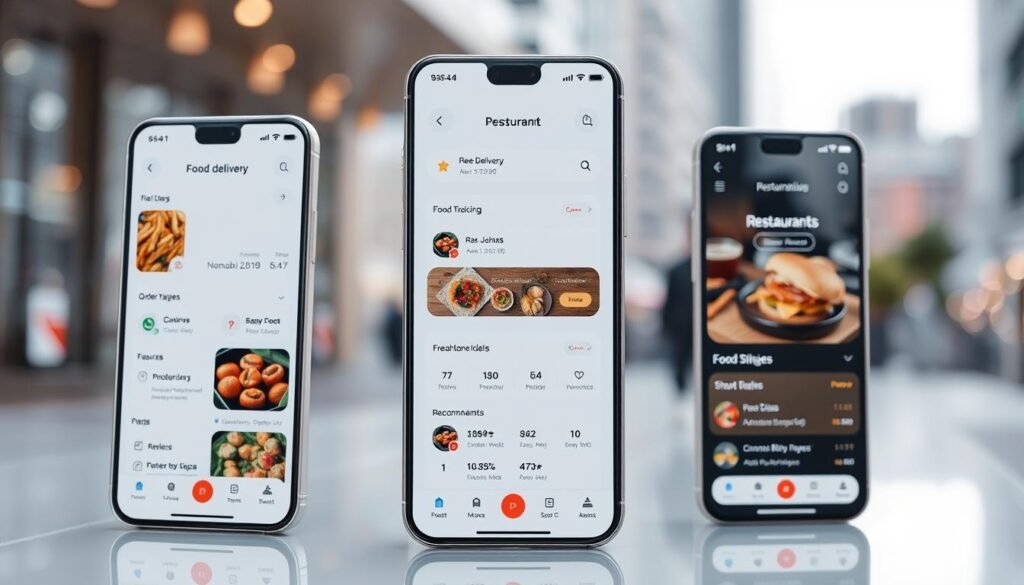What if you could get your favorite restaurant meal delivered with just a few taps? That vision became reality in the Middle East thanks to a game-changing food delivery platform. Starting small in 2004, it grew into a market leader, reshaping dining habits across the region.
Founded by Abdulaziz Al Loughani and Khaled Alotaibi, this business pioneered convenience in the food industry. Its $170 million acquisition marked the largest tech exit in the region at the time. Today, it processes millions of orders monthly through thousands of restaurant partners.
The platform’s success comes from understanding customer needs. Features like real-time order tracking and multiple payment options set new standards. Its tech-driven approach made food delivery faster and more reliable than ever before.
Key Takeaways
- Pioneered food delivery services in the Middle East region
- Achieved record-breaking $170 million acquisition deal
- Controls majority share of UAE food delivery market
- Introduced innovative features like live order tracking
- Partners with thousands of restaurants across multiple countries
The Birth of Talabat: A Vision for Convenience
In 2004, a group of Kuwaiti students saw an opportunity to revolutionize food delivery. Inspired by Egypt’s Otlob, they launched a modest platform as a university project. Their goal? To simplify ordering for busy customers.
Founding and Early Challenges
The startup faced tough odds. Kuwait’s internet penetration was just 23%, and skeptics doubted online food orders would catch on. Conversion rates hovered at 1%, with only 200 daily orders generating $10K monthly revenue.
Abdulaziz Al Loughani, a determined entrepreneur, saw potential. In 2007, he secured a $1M loan to buy a 90% stake. He slashed his salary to $1K/month to repay debts, proving his commitment to the team.
The Role of Abdulaziz Al Loughani
Al Loughani’s leadership turned the tide. He introduced gamification, like Audi A4 giveaways, to boost engagement. His risk paid off—user trust grew, and the platform gained traction in Kuwait’s competitive sector.
By 2008, the founders had laid the groundwork for regional dominance. Their story shows how vision and resilience can redefine an industry.
From Local Startup to Regional Powerhouse
Transforming from a small Kuwaiti operation to a regional leader didn’t happen overnight. Strategic expansions and tech-driven solutions fueled its rise across the GCC. By 2009, it captured 70% of the market in Saudi Arabia alone, proving the demand for convenient food delivery.
Early Growth and Market Penetration
The Saudi expansion wasn’t flawless. A franchise model initially backfired, forcing a 2009 buyback to regain control. Yet, the move paid off—cash-flow positivity followed within two years.
By 2012, a mobile app doubled its reach. Real-time tracking and seamless payments attracted more orders, solidifying its lead in the sector.
Key Milestones in the GCC
Growth accelerated with entries into Bahrain (2013), Jordan (2016), and Egypt (2019). Each launch adapted to local tastes, from payment methods to restaurant partnerships.
Fifteen years saw partnerships explode from 30 to 5,500+ restaurants. Landmark deals, like becoming Expo 2020 Dubai’s official provider, cemented its reputation.
For entrepreneurs, the platform’s journey offers lessons: scale with precision, learn from missteps, and leverage tech to save time for customers.
The $170 Million Game-Changer: Acquisition by Rocket Internet
A $170 million deal reshaped the Middle East’s food delivery landscape overnight. In 2015, Rocket Internet acquired the platform, merging it with 10 other food brands to dominate the sector. The move wasn’t just about expansion—it was a tech play to optimize delivery fleets and streamline operations.
Why Rocket Internet Invested
Rocket Internet saw untapped potential in the region’s fragmented food delivery market. Their strategy? Consolidate competitors under one umbrella. Post-acquisition, they upgraded tech stacks and introduced AI-driven routing, cutting delivery times by 20%.
Impact on the MENA Tech Ecosystem
The deal shifted investor mindsets. Suddenly, Gulf-based startups gained credibility. Kuwait’s National Fund launched $7B SME programs, inspired by the exit. Even founders like Fishfishme’s CEO noted newfound parental approval—a cultural shift toward entrepreneurship.
Rocket’s bet paid off: the platform spurred a $650M funding round, proving the impact of scalable tech in emerging markets.
How Talabat Works: A Seamless Food Delivery Ecosystem
Behind every successful food delivery lies a well-oiled system connecting hungry users to their favorite meals. The platform thrives as a three-sided marketplace, linking customers, restaurant partners, and riders through intuitive tech.
User Experience: Ordering to Delivery
From craving to fulfillment, the journey takes four steps. Users search menus, customize meals, pay via multiple options, and track orders in real time. Scheduled deliveries and promo integrations add convenience.
The app website handles 25K daily pageviews, proving its reliability. Live GPS updates ensure transparency, while AI predicts delays before they happen.
Restaurant Partnerships and Benefits
For eateries, joining the platform means tapping into a ready customer base. Commissions (15–25%) often cost less than traditional marketing. Digital menus and performance analytics help optimize sales.
During COVID-19, the pivot to groceries and pharma saved many restaurant partners. Integrated POS systems streamlined operations, reducing errors by 30%.
Delivery Fleet Management
The delivery fleet is the backbone. Riders earn ~$5 per trip with flexible hours. Their app includes GPS navigation and an earnings dashboard.
AI dispatches the nearest rider, cutting wait times. During peaks, surge pricing balances demand. This tech-driven approach keeps the ecosystem humming.
Talabat’s Business Model: Driving Profit in a Competitive Market
Profitability in food delivery requires a smart mix of pricing and partnerships. The platform’s business model thrives on three pillars: commissions from restaurants, delivery charges, and advertising revenue. This balance ensures steady growth while keeping operational costs lean.
Revenue Streams: Commissions, Delivery Fees, and Ads
Restaurants pay 15–25% per order, while customers cover delivery charges ($2–5). High order density boosts margins—70% in busy areas. Ads add another layer: eateries bid for top listings, generating $10K+ monthly.
Compared to DoorDash, the platform’s ad-tier system is simpler. Premium placement auctions drive competition without confusing users. Brand dominance also cuts customer acquisition costs by 30%.
Cost Structure and Scalability
Operations eat 45% of revenue (rider payouts, support). Marketing and R&D split the rest. Cloud kitchens are a game-changer—owning virtual brands slashes kitchen overhead by 40%.
Scaling is tech-led. AI optimizes delivery routes, and shared fleets reduce idle time. This cost structure lets the platform expand without sacrificing profit.
Technological Innovations That Set Talabat Apart
Technology has reshaped how people order food, with intuitive features setting new industry standards. The platform’s tech stack solves real pain points—from reducing wait times to personalizing menus. Its award-winning tools keep users and restaurants coming back.
Mobile App and Website Features
The mobile app, launched in 2012, was the first in MENA to offer scheduled orders. Users love its dietary filters (gluten-free, vegan) and group ordering for shared meals. BBC Good Food named it “Food Delivery App of the Year” for its seamless design.
Key upgrades include:
- Group ordering: Split bills effortlessly for office lunches or family dinners.
- API integrations: Apple Pay and Google Pay streamline checkout.
- Feedback users shape updates—90% of feature requests come from reviews.
- 3DS2 authentication cuts fraud by verifying high-risk transactions.
Real-Time Tracking and Customer Support
Real-time tracking slashed support tickets by 30%. Users watch their rider’s GPS path, with ETAs updating dynamically. During delays, AI alerts customers before they ask—a game-changer for trust.
The customer support team speaks Arabic, English, and Urdu. An AI chatbot handles 80% of queries, like refunds or missing items. For complex issues, live agents step in within 90 seconds.
These innovations prove one thing: tech isn’t just about speed—it’s about building relationships through reliability.
Expanding Horizons: Talabat’s Market Dominance
Dominating a regional market requires more than just great tech—it demands cultural adaptation. The platform’s entry into the United Arab Emirates proved this rule, achieving 97% Dubai coverage within 18 months. Success came from tailoring every aspect of the business to local preferences.
Mastering the UAE Market
Unlike Kuwait’s cashless preference, the United Arab Emirates relied heavily on cash-on-delivery until 2018. The platform adapted by offering multiple payment options, including installment plans during Ramadan. Festival-specific menus for Eid and National Day boosted engagement by 40%.
Cloud kitchens became a smart strategy for serving expat communities. Virtual brands replicated home-country flavors for Indian, Filipino, and Pakistani workers. This approach cut overhead while expanding menu variety—a win-win for customers and restaurants.
Localized Strategies Across Borders
Egypt presented unique challenges that required creative solutions. Delivery-by-boat in Nile communities showed the way forward for last-mile logistics. In Iraq, partnerships with the Baghdad Food Bank ensured reliable operations despite infrastructure gaps.
Ramadan promotions became a revenue powerhouse, generating 40% of annual sales. Limited-time offers and charity tie-ins strengthened brand loyalty. Each market entry followed the same strategy: study local habits, then build solutions around them.
The platform’s business model thrives on this flexibility. Whether adapting to payment preferences or festival calendars, localization remains key to maintaining regional leadership.
Conclusion: Lessons from Talabat’s Success
Entrepreneurs can learn valuable lessons from MENA’s food delivery revolution. The platform’s journey highlights a winning strategy: first-mover advantage paired with deep cultural adaptation. Abdulaziz Al Loughani’s debt-driven persistence became a blueprint for turning risks into rewards.
Its impact was amplified by MENA’s 300% smartphone growth (2005–2015), proving tech adoption fuels scalability. For startups, the takeaway is clear: balance global models with hyper-local execution.
The Kuwait National Fund trained 5,000+ entrepreneurs by 2020, reflecting the region’s shift toward lean methodologies. As food tech evolves, vertical integration—like cloud kitchens—will redefine the way platforms operate.
FAQ
Who founded the company?
Abdulaziz Al Loughani was a key figure in its early days, helping shape its vision for convenience in the Middle East.
How did the business expand across the GCC?
By focusing on strategic market penetration and forming strong partnerships with restaurants, it quickly grew into a regional leader.
Why did Rocket Internet acquire the platform?
The 0 million deal highlighted its potential to dominate the MENA tech ecosystem, offering scalability and innovation.
What makes the ordering process seamless?
The mobile app and website provide real-time tracking, multiple payment options, and quick customer support for a smooth experience.
How does the company generate revenue?
It earns through commissions from restaurant partners, delivery charges, and advertising space on its platform.
What technological features set it apart?
Advanced features like live order tracking, AI-driven recommendations, and secure payment gateways enhance user satisfaction.
How did it adapt to new markets like the UAE?
By tailoring its approach to local preferences, optimizing delivery logistics, and expanding restaurant choices for users.
What challenges did it face early on?
Building trust with restaurant partners, managing delivery fleets, and standing out in a competitive market were key hurdles.
How does it support small businesses?
By giving local restaurants access to a wider customer base, flexible pricing models, and marketing tools to boost visibility.
What impact did it have on the food delivery sector?
It revolutionized convenience, setting new standards for speed, reliability, and customer service in the region.










